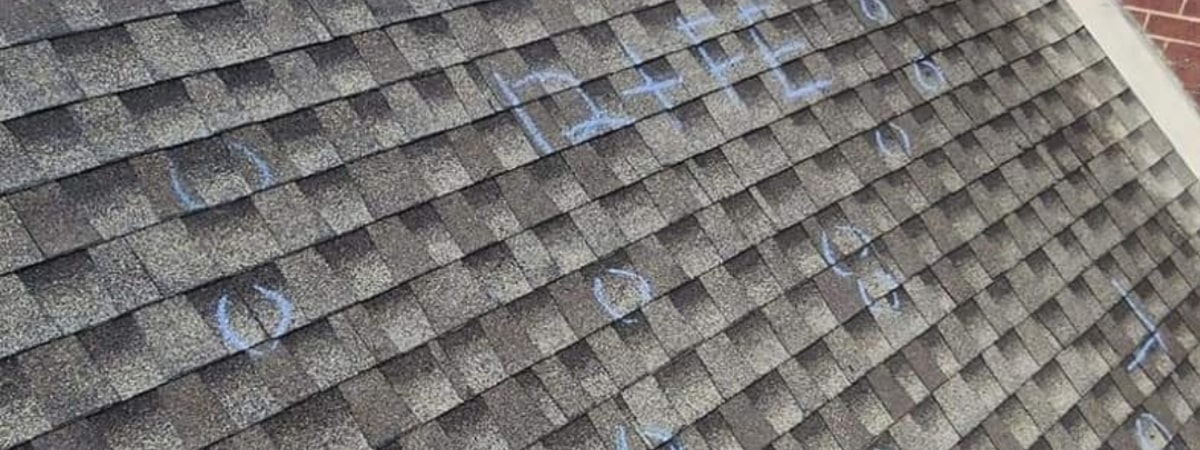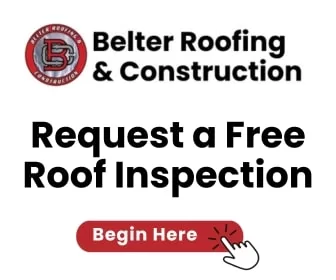Oklahoma Hail Damaged Roofs
Waking up in the morning after a heavy Oklahoma thunderstorm to find hail damage on your automobile isn’t an excellent way to start the day.
Depending on the size of the hail, it can inflict substantial damage not just to your automobile but also to the rest of your property.
Your roof is an essential aspect of your property to consider when it hails. Hail will reduce your roof’s longevity and may necessitate a total residential roof replacement if left unchecked.
However, hail damage on a roof might be difficult to detect if you don’t know where to check. That is why we will describe how hail damage appears on your roof.
Since 2015, Belter Roofing and Construction has provided Oklahoma residents with roof claim assistance and counseling through the insurance process. After your claim is granted, we work relentlessly to ensure that your insurance carrier offers you whatever you require for your roof. Because of this, we like to say, “We work for you, not the insurance company.”
By the conclusion of this article, you’ll better understand what hail damage looks like on a roof, how to recognize it from the ground, and three important things to consider before beginning the insurance process.
What is Oklahoma Hail?
Hail is a type of precipitation made up of solid ice that occurs inside thunderstorm updrafts. Hail may cause damage to roofs, buildings, and automobiles, as well as cattle and humans.
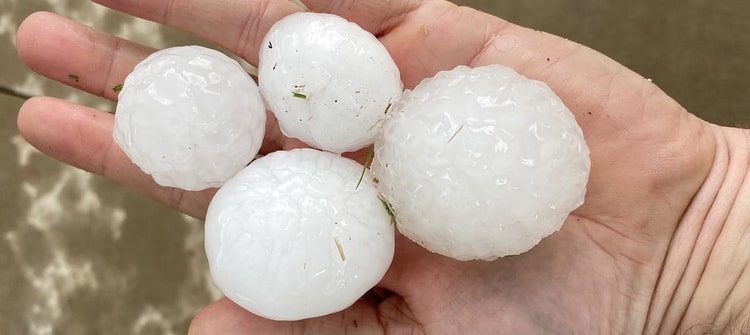
The largest hailstone recovered in the United States fell on June 23, 2010, in Vivian, South Dakota, and measured 8 inches in diameter and 18.62 inches in circumference. It weighed 1 pound and 15 ounces.
Oklahoma hail storms can create hail from 1/4 in diameter, commonly known as “pea” sized, to 4 1/2 inches in diameter or “grapefruit” size.
What Size Hail Can Damage a Roof?
Oklahoma hail 1″ in diameter or larger will cause damage to your roof and necessitate filing an insurance claim. When hail of this size falls, it causes dents and dings in asphalt shingles and jeopardizes the roof’s overall integrity.
Any hail that is bigger than that, however, can begin to harm your roof and other surfaces. Hail can cause severe roof damage once it measures 1.5 inches in diameter or is the size of a ping pong ball.
Even larger hail, 1.75 inches in diameter (golf ball size), can seriously damage buildings, roofs, and vehicles parked outside.
In addition to size, the speed of the wind also affects how much damage the hail does. Severe winds that frequently accompany hailstorms increase the damage.
Never assume that your home or business is unaffected by hail simply because it appears small. Always take a moment to inspect your property visually.
We highly recommend contacting a certified roofing company and requesting a free Oklahoma roof inspection if your home or business is hit by hail 1″ or larger.
What Does Hail Damage Look Like on a Roof?
Your roof’s hail damage can be either hard to spot or very noticeable. You will notice dents or dings on your shingles if the hail is sufficiently large (1″ in diameter or larger).
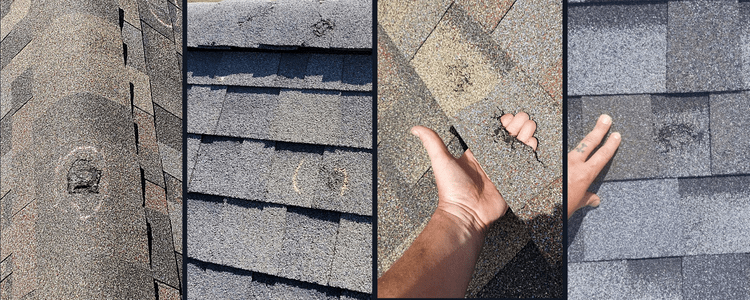
However, just because your roof’s shingles are not torn or severely dented doesn’t mean that hail damage didn’t happen.
Dents, dings, and splatter marks on your roof flashing, gutters, roof vents, and other roof penetrations are additional signs of hail damage.
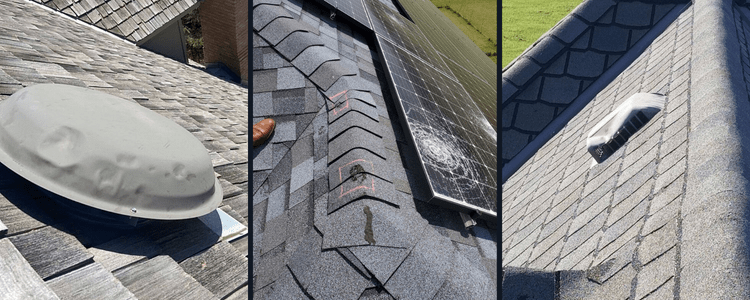
There’s a good chance you’ll need to file a homeowners insurance claim if your roof has any of the damage mentioned above.
If you suspect roof damage, our advice is to contact a local Oklahoma roofer before contacting your insurance company.
A certified roofing company will be familiar with the Oklahoma insurance process and be able to provide you with clarity and direction on how to file your claim.
However, until your insurance adjuster approves the hail damage claim, a local roofing contractor cannot perform any repair or replacement work.
Signs to Check for Hail Damage on Your Oklahoma Home or Business
We don’t advise anyone unfamiliar with safe roof-walking techniques to look for the damage mentioned above.
When your insurance provider sends someone out to inspect it, they are familiar with these techniques, and walking on the roof is not worth the risk of a fall.
There are still some signs of hail damage you can look for without getting out a ladder, even if you can’t see your entire roof from the ground.
If you notice one or more of these symptoms, there may be additional hail damage to your roof.
- Vehicles – Dents on the hood and top of your vehicle
- Garage Doors – Your garage door may have dents, dings, or hits.
- Mailbox – Your mailbox and other soft metals on your property have dents.
- Gutters – Dents in gutters along the trim of the house.
- Downspouts – Dents that are above approximately five feet.
- Windows – Cracks or broken windows or torn screens.
- Shutters or Siding – Dings to painted wood, siding, or shutters
- Additional Damage – Grill, air conditioner, or electric meter dings or splatter marks
What You Should Know Before Starting the Insurance Claim Process
After learning to recognize what hail damage looks like, there are a few things you should know before making a claim.
Here are 3 things you should be aware of before filing an insurance claim.
Insurance Can Be Complex and Confusing
The reputations of the insurance and roofing industries are not good.
Unfortunately, there are many roofing and insurance companies out there that aren’t always looking out for your best interests. We like to say that the insurance process can be complex and confusing because of this.
Some unethical businesses take advantage of this and con homeowners anxious to fix roof problems.
We are not saying that all insurance or roofing companies are out to rip you off.
We’re just trying to let you know that, regrettably, there are people on both sides who attempt to take advantage of people in tense circumstances.
Being aware of this from the outset enables you to prevent something similar from happening to you.
Don’t Sign Anything Until Your Hail Damage Claim is Approved
As I previously stated, the roofing industry doesn’t have the best reputation. The fact that some roofing companies try to pressure you into signing documents before they inspect your roof is one of the reasons it developed this reputation.
Unethical roofers may use terms like “we are running out of time,” “spots are filling up fast,” or “you don’t want to be left behind.” Don’t fall for these pressure tactics. They are after the all-mighty dollar and not your best interests.
Do not rush through the roofing process. Wait until the insurance company approves your claim before signing anything from a roofing contractor.
An unethical roofer is attempting to lock you into a contract that gives them the right to your roof before your claim is approved if they want you to sign something. Once you sign, you won’t be able to pick your roofing contractor in this situation.
A trustworthy roofing contractor, on the other hand, will guide you through the insurance process and provide you with a straightforward assessment of whether or not the storm has damaged your roof.
Once your insurance claim is accepted, they will approach you about doing business.
Insurance Adjusters Make Mistakes
Even the best insurance adjusters make mistakes because they are only human.
An insurance adjuster will typically find storm damage, but occasionally they will make a mistake and reject your claim. (Another reason you should have a local roofer familiar with the process is to do a free roof inspection before contacting your insurance agent.)
There is no need to become anxious if they refute your claim. There are methods for thoroughly inspecting your roof for storm damage.
Asking a different insurance adjuster to examine your roof is the best way to get a second opinion. If your claim is accepted, that’s great, but occasionally the second adjuster will continue to maintain that the roof is unsuitable for a claim.
After the second adjuster rejects your claim but you still believe you have storm damage, you can hire an engineer to visit your house, examine the roof, and then provide your insurance company with any necessary documentation to support your claim for a new roof due to storm damage.
We Can Help You With the Roof Claim Process
You are now prepared to call your Oklahoma insurance provider and begin the claim process if you believe you have hail damage on your residential or commercial property.
However, you should ask yourself, “Do I know what to expect from the process?” before contacting the insurance company. You are not alone if you don’t.
The process can be challenging and stressful if you’ve never filed an insurance claim. We outlined the steps in filing a homeowners insurance claim to help you prepare for dealing with your insurance provider.
Since 2015, the staff at Belter Roofing and Construction has assisted Oklahoman homeowners with their insurance claims.
We’ll work with you and your insurance provider to ensure you have a positive experience if a significant storm damages your roof.
Reach out to us if you live anywhere in Oklahoma and have hail or other storm damage so we can support you during this trying time.
We place a high value on earning your trust. We’ll do the job well and communicate openly and frequently. We advise using materials demonstrated and tested to withstand severe Oklahoma weather.
Learn more about our roof insurance claim assistance available to Oklahoma residents and business owners.
Oklahoma Hail FAQs
Can solar panels be damaged by hail?
Hail can indeed cause damage to solar panels. Manufacturers must put the solar panel’s top glass through tests simulating the impact of rain and pass them. Solar panels are still occasionally harmed by hail, though.
Should I replace my roof after hail damage?
After a hailstorm, you may need to replace your roof. Storms with hail can seriously harm roofs, especially older ones. Older roofs are typically weaker and more prone to damage, so that a roof replacement may be necessary after hail damage.
Can Oklahoma hail damage window seals?
Yes, hail damage can break your window seals and cause glass cracks. The window may sustain severe damage from hailstones that are 1.5 inches in diameter or more extensive. This may cause the broken window panes to allow moisture and air infiltration.
What is the largest hailstone recorded in the United States?
On June 23, 2010, a hailstone measuring 8 inches in diameter and 18.62 inches in circumference fell in Vivian, South Dakota, making it the largest hailstone ever found in the country. 1 lb 15 oz. was its weight.
How is Oklahoma hail size measured?
When reporting hail, measurements made with a ruler, calipers, or tape measure are preferable to estimates made by comparing the hail to a known object of definite size.
- 1/4 inch diameter – Pea
- 1/2 inch diameter = Mothball
- 3/4 inch diameter = Penny
- 7/8 inch = Nickel
- 1 inch = Quarter — hail quarter size or larger is considered severe
- 1 1/2 inch = Ping-Pong Ball
- 1 3/4 inches = Golf Ball
- 2 1/2 inches = Tennis Ball
- 2 3/4 inches = Baseball
- 3 inches = Teacup
- 4 inches = Softball
- 4 1/2 inches = Grapefruit
How fast does hail fall to the ground?
This is a complex question. Many factors determine the speed a hailstone falls. Size, melting, and wind speed, to name a few.
The anticipated fall speed for hailstones under one inch in diameter is 9 to 25 mph. The expected fall speed is between 25 and 40 mph for hailstones that one typically sees in a severe thunderstorm (1 inch to 1.75 inches in diameter). The expected fall speed is between 44 and 72 mph in the strongest supercells that produce some of the largest hail ones might expect to see (2 inches to 4 inches in diameter).
Due to variations in the hailstone’s shape, level of melting, fall orientation, and environmental factors, there is a lot of uncertainty in these estimates.
Large hailstones with diameters greater than 4 inches, however, have the potential to fall at speeds of more than 100 mph.
In Conclusion
Hail damage may appear undetectable initially, with a few dents and discoloration.
Many of the most critical problems, however, are only evident to expert roof inspections.
Let's Have a Conversation
Table of Contents
- Introduction
- What is Oklahoma hail?
- What size hail can damage a roof?
- What does Oklahoma roof damage look like on a roof?
- How to tell if you have hail damage
- Three things to know before filing a roof claim
- Belter Roofing can help you with the claims process
- Oklahoma hail damage FAQs
- In conclusion
Share this Article

